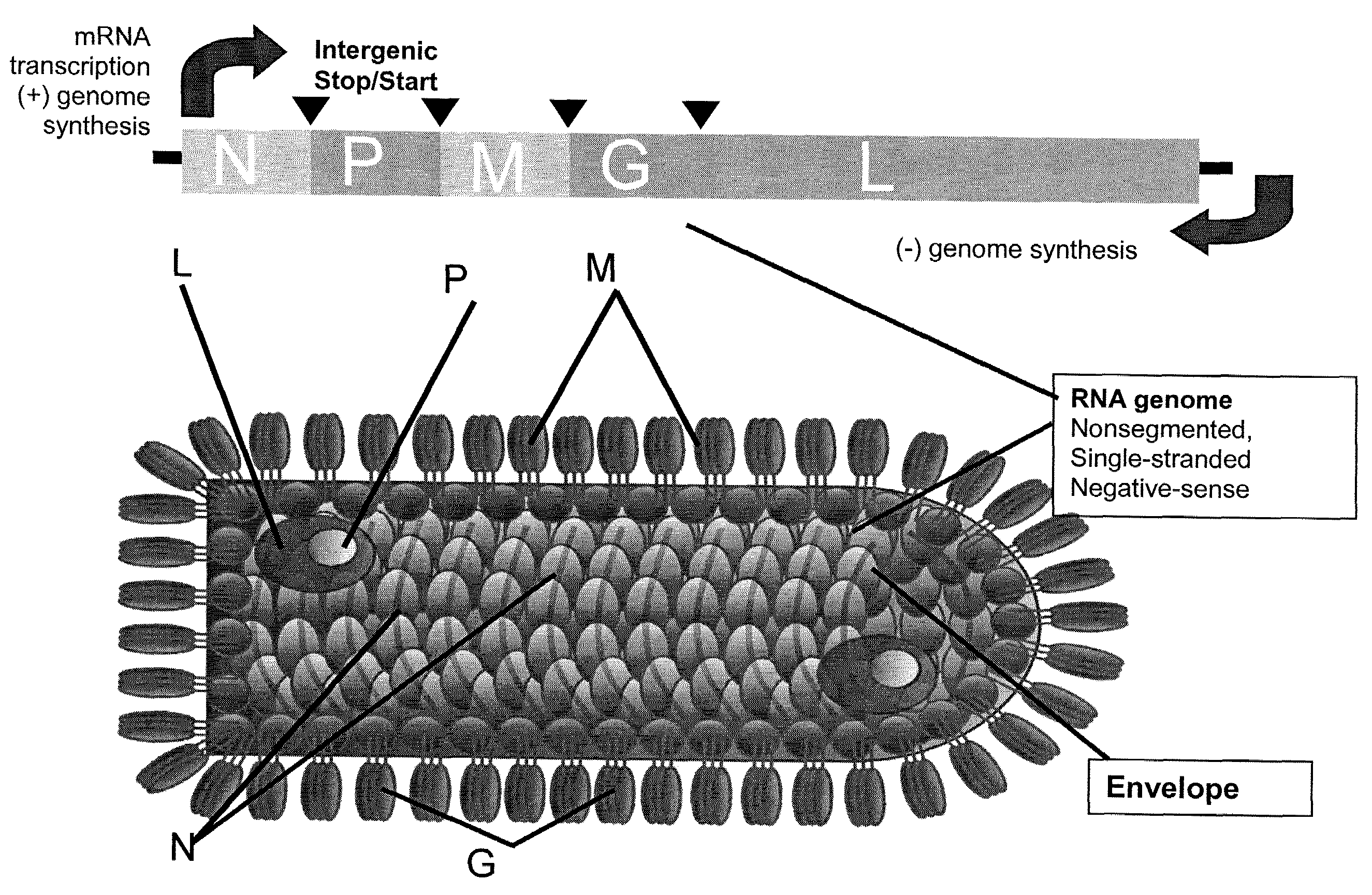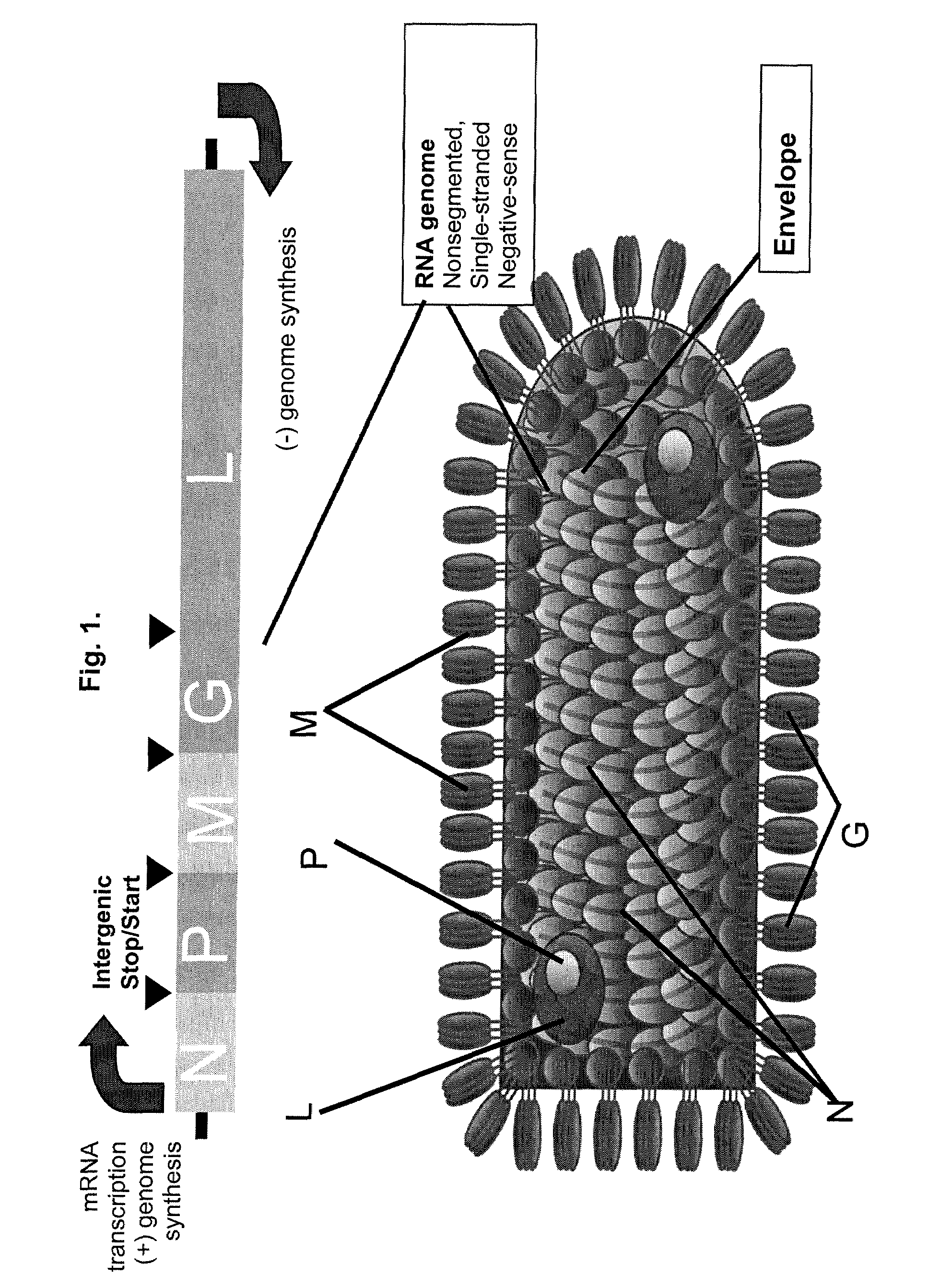Methods for packaging propagation-defective vesicular stomatitis virus vectors using a stable cell line that expresses g protein
a propagation-defective and stable cell line technology, applied in the field of negative-strand rna viruses, can solve the problems of complex g protein expression levels, insufficient clinical development, toxic to cells, etc., and achieve the effect of improving the packaging
- Summary
- Abstract
- Description
- Claims
- Application Information
AI Technical Summary
Benefits of technology
Problems solved by technology
Method used
Image
Examples
example 1
Preparation of Recombinant DNA
[0182]A plasmid vector encoding T7 RNAP (pCMV-T7) was prepared by cloning the polymerase open reading frame (ORF) into pCl-neo (Promega) 3′ of the hCMV immediate-early promoter / enhancer region. Before insertion of the T7 RNAP ORF, pCl-neo was modified to remove the T7 promoter located 5′ of the multiple cloning site, generating vector pCl-neo-Bcl. The T7 RNAP gene was inserted into pCl-Neo-BCl using EcoR I and Xba I restriction sites incorporated into PCR primers used to amplify the T7 RNAP coding sequence. A Kozak (Kozak, J Cell Biol 108, 229-241, 1989) consensus sequence was included 5′ of the initiator ATG to provide an optimal sequence context for translation.
[0183]Plasmids encoding VSV N, P, L, M and G polypeptides were prepared by inserting the appropriate ORFs 3′ of the T7 bacteriophage promoter and encephalomyocarditis virus internal ribosome entry site (IRES) (Jang et al., J Virol 62, 2636-2643, 1988; Pelletier and Sonenberg, Nature 334, 320-32...
example 2
Initial Investigation of the Effect of Increased Abundance of VSV G on Packaging of Propagation-Defective VSVS
[0186]Studies were conducted to identify conditions that supported maximal G protein expression from plasmid DNA. Empirical research performed earlier identified electroporation as a method that promoted reproducible and efficient introduction of plasmid DNA into Vero cells (Parks, et al., 2006, Method for the recovery of non-segmented, negative-stranded RNA viruses from cDNA, published United States patent application 20060153870; Witko, et al. J Virol Methods 135:91-101) and subsequent method refinement relied on this finding, because electroporation is a scalable technology (Fratantoni, et al. Cytotherapy 5:208-10, 2003), and because Vero cells are a well characterized cell substrate that has been used for production of a live rotavirus vaccine (Merck, RotaTeq (Rotavirus Vaccine, Live, Oral, Pentavalent) FDA. Online, 2006 posting date; Sheets, R. (History and characteriza...
example 3
Preparation of a Stable Cell Line that Expresses VSV G Protein
[0190]The present example describes the preparation of a stable cell line that was used to supply genetic complementation for development of propagation-defective viral vectors. Although an attractive approach by which to produce propagation-defective vectors, stable complementing cell lines can be difficult to produce and maintain, particularly when the complementing gene product is toxic like VSV G. Previous attempts to produce Vero cells expressing G under control of tetracycline-responsive systems (Corbel and Rossi Curr Opin Biotechnol 13: 448-52, 2002) failed, prompting the present investigation of additional approaches (data not shown).
[0191]The stable cell line developed by Applicants employs the heat shock response as an attractive alternative to chemical inducers. Promoters controlling expression of heat shock proteins (HSPs) have been used before to control expression of a foreign gene (Rome et al. Methods 35: 1...
PUM
| Property | Measurement | Unit |
|---|---|---|
| temperature | aaaaa | aaaaa |
| temperature | aaaaa | aaaaa |
| temperature | aaaaa | aaaaa |
Abstract
Description
Claims
Application Information
 Login to View More
Login to View More - R&D
- Intellectual Property
- Life Sciences
- Materials
- Tech Scout
- Unparalleled Data Quality
- Higher Quality Content
- 60% Fewer Hallucinations
Browse by: Latest US Patents, China's latest patents, Technical Efficacy Thesaurus, Application Domain, Technology Topic, Popular Technical Reports.
© 2025 PatSnap. All rights reserved.Legal|Privacy policy|Modern Slavery Act Transparency Statement|Sitemap|About US| Contact US: help@patsnap.com



